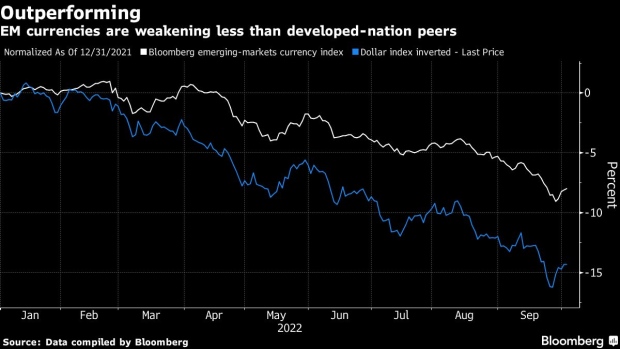Oct 16, 2022
Emerging Markets Hurt Less as Dollar’s Wrath Sinks Rich Nations
, Bloomberg News

(Bloomberg) -- Sign up for the New Economy Daily newsletter, follow us @economics and subscribe to our podcast.
Citigroup calls it a “head scratcher.” Goldman Sachs terms it “striking resilience.” For Columbia Threadneedle, it’s a “reward for proactiveness.”
Whichever way one describes it, the relative resilience building up in emerging-market currencies over their advanced-nation peers has money managers sitting up and taking notice.
The dollar’s rally to successive records has currencies across the world in a spiral of doom. But a closer look reveals the benchmark gauge for emerging-market exchange rates is posting only half the losses seen in developed countries. And uncharacteristically, this outperformance continues even as commodity prices -- the mainstay of poorer nations -- are tumbling.
“In the last couple of months, prices of commodities have reversed from the levels seen earlier in the year but commodity producers have still performed relatively well compared with the euro zone or Group of 10,” said Dirk Willer, the head of emerging-market strategy at Citigroup Inc. “That’s been a bit of a head scratcher.”
Developing nations’ success in weathering some of the volatility tied to Federal Reserve monetary tightening questions the assumption that they will be the epicenter of any market meltdown driven by higher US yields. In reality, much of the pain is being felt in the UK and Europe, while countries like Brazil and Mexico are seeing their currencies lure investors with juicy yields -- the result of some of the world’s most aggressive rate hikes.
“We are seeing in developed markets the same forces that emerging markets have grappled with for the past few decades; inflation pressures and fiscal deficits,” said Simon Harvey, head of currency analysis at Monex Europe in London. “With all the volatility going on, you are forced to search for higher returns and that’s in emerging markets.”
A commodity rally this year through June 9 helped MSCI Inc.’s benchmark for developing-nation currencies limit its drop to 2.5%, when the gauge representing developed nations retreated 7.4%. Since then, the raw-material gauge has plunged, but emerging markets have still outperformed the Group of 7 by 2 percentage points. In all, of the 23 developing currencies tracked by Bloomberg, 21 have beaten the British pound, 19 have outperformed the euro and all 23 have done better than the Japanese yen.
First World Problems
As the world lurches from crisis to crisis -- from the war in Ukraine to energy squeeze in Europe and political turbulence in the UK -- the reputation of developed countries as safer investment destinations has taken a beating. Options traders are taking note. Expected volatility in G7 currencies has surged above that of emerging markets for the first time since March 2020, according to JPMorgan Chase & Co. indexes.
Then comes the rate differential. None of the G-10 currencies has a policy rate above 3%, while developing nations offer much higher carry: Indonesia’s 4.25% is among the lowest, and Brazil’s policy rate exceeds 13%.
“Some emerging-market central banks were fairly early to hike policy rates starting mid-2021 and are now being rewarded for it,” said Lin Jing Leong, a rates strategist at Columbia Threadneedle Investments. “This is a great example of how some early proactiveness can go a long way in markets.”
Currency outperformance in Mexico and Brazil is driven by positive real rates, according to Citigroup. The bank is overweight the peso, calling it “the darling of emerging markets.” Stronger external accounts and attractive carry are the main drivers for the region, Morgan Stanley says.
“The macro problems in Europe and the policy divergence in Japan is unlikely to clear up soon,” said Alvin Tan, the head of Asia currency strategy at RBC Capital Markets. “So I am not expecting their currency underperformance to be resolved anytime soon.”
In countries like Brazil, easing inflation is helping to cushion the blow from a stronger dollar.
“That is extremely important as that means you don’t have deeply negative real rates, which we are seeing in many of these G-10 economies,”said Aninda Mitra, a macro and investment strategist at BNY Mellon Investment Management.
But all this talk of outperformance is tempered by the fact that most emerging-market currencies are still falling. Goldman Sachs Group Inc. and Societe Generale SA see further losses until the Fed halts rate hikes.
“Emerging-market currencies will remain on the back foot in the remainder of the year,” said Marek Drimal, a Societe Generale strategist. “They are cheap, but will become attractive only after the end of Fed’s tightening is near and if, at the same time, the global or the US economy avoids a hard landing scenario.”
What to watch this week:
- China’s Communist Party opened its once-every-five-year congress on Sunday, where Xi Jinping looks set to secure another term as party chief and a new line-up of party leaders will be introduced
- China’s central bank halted its cash withdrawal via medium term loans for the first time in three months in a bid to boost the economy
- On Tuesday, third-quarter GDP likely to show only a weak recovery and September activity highlighting consumption weakness and the important role public investment is playing in propping up the recovery
- Domestic politics are likely to force Turkey’s central bank to ignore soaring inflation and accelerate the pace of interest-rate cuts
- In Brazil, the coming week will bring August economic activity data; Jair Bolsonaro and Luiz Inacio Lula da Silva meet on Oct. 16 for their first televised presidential debate following the first round of the election
- Mexico’s retail sales likely extend their uptrend in August despite high inflation and tight monetary conditions
(Updates with China stopping its cash withdrawal via medium-term loans in the What to Watch section. An earlier version of the story was corrected to remove a chart with out-of-date rates for Peru and Chile)
©2022 Bloomberg L.P.







